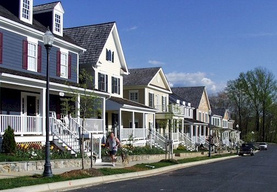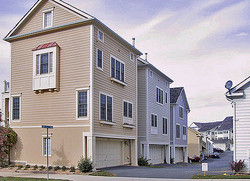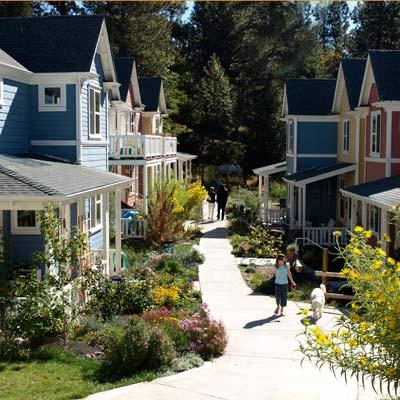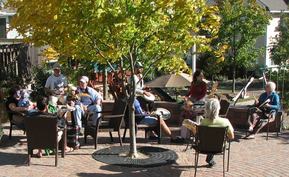|
By Peter Lazar  New Urbanism purports to solve the loneliness and disconnection that plagues our car-centric suburbs. The theory is that traffic problems will be solved and people will start to interact if you just remove the cul-de-sacs, cram the houses close together with friendly porches and move the cars to alleys in the back. But when I drive through a brand new New Urbanist neighborhood on a beautiful Friday afternoon at 5:30pm, the front porches are empty. I see nobody interacting in front. Where is everyone?  I see a car drive by and follow it. It goes behind the house into an alley. A garage door magically opens and the car drives in. The person has entered his house from a tunnel. By not walking by neighbors' houses, he has missed the opportunity to chat a bit. Such 5 minute encounters build up social capital that leads to more meaningful relationships. And were do the kids play? I should have taken a picture, but I was driving by one of these places and I saw the kids rolling around back on their bigwheels. Where can the parents and their friends hang out and watch? There are porches in front, but there’s no place to play there. So here’s the solution: Move the cars to the periphery, and put the people in front! This is a typical cohousing neighborhood with a pedestrian-oriented street. And here’s another cohousing neighborhood with a pedestrian plaza. Notice all the people hanging out. That's a typical afternoon in cohousing. This is how we should design our neighborhoods.
First Photo: BeyondDC, Creative Commons attribution license Second Photo: Brett VA, Creative Commons attribution license Third Photo: David Shankbone, GNU Free Documentation License Fourth Photo: Sunward Cohousig. Mconavon, GNU Free Documentation License
0 Comments
were not those with the greatest relative parent happiness. Rather, according to the study lead, Dr. Jennifer Glass of the University of Texas, "Policies that made it less stressful and less costly to combine child rearing with paid work “seem to be the ones that really matter.”
A New York Times article about this study went further through interviews to conjecture that in the U.S., there is an incredible anxiety about parenting for a number of reasons. We don't have the support networks. We have to compete for activities because a child's entire fate seems to depend on going to the right college and so many factors lead to that. We are constantly afraid of abductions. We worry about our kids being hit by cars. The article interviews Christine Gross-Loh, the author of “Parenting Without Borders,”. Gross-Loh says “In Japan, my 6-year-old and my 9-year-old can go out and take the 4-year-old neighbor, and that’s just normal,”. In the United States, of course, that kind of freedom usually draws heavy criticism and can even lead to interventions by Child Protective Services. Living in a cohousing neighborhood, where my kids were free to roam the neighborhood in packs by age 4, I feel like I'm definitely outside the norm. With cars out of the picture and in knowing all our neighbors, I could feel safe to do so. My neighbors with young children free up time for each other sometimes by taking turns watching each others' kids. And a short walk away are several teens and preteens who are happy to babysit and don't have to drive over to do so. Photo by Watchcaddy, Flickr Creative Commons Front-facing kitchens, standard in cohousing, build community. You look out your kitchen window while cooking or cleaning dishes and see the action. If you see someone you'd like to talk with or something fun happening, you can put down those dishes and go outside. But that same kitchen in front enables a very private living room in back. With living rooms in back, cohousing homes are more private than typical clustered houses.
Some New Urbanist neighborhoods have homes where the back windows face windows in other homes. Sometimes there's only a garage and no yard out back. The developers just want to pack as many houses onto postage stamp yards as possible. But a typical cohousing neighorhood, built for lifestyle over profit, often has a very private back yard with beautiful scenery and little ability to see neighbors. When you sit on a cohousing front porch reading a book, it's fair game for a neighbor to start a conversation. That's part of the reason you are there. But if you're on your back deck, it's a cultural taboo for anyone to yell up and say "hello." Perhaps one reason that cohousers recognize the importance of privacy is that so many of them are introverts. If you're not living in cohousing, you might be surprised to learn that Myers Briggs tests repeatedly find the majority of cohousers are introverts. There are indeed many extroverts, but there are generally more introverts. As an introvert myself, who also likes people, I find cohousing the perfect balance. I have plenty of privacy when I need it. And when I'm in a mood for community, it's so easy and simple. There are regularly-scheduled meals and events every week. This means I can show up if I feel social. But the events will happen with or without me. Unlike a party invitation where I feel bad if I don't show up, there is no expectation for me to be at these regular events. In cohousing, you can have a social life on your own terms and at your own time when you are feeling social. Furthermore, spontaneous events happen all the time. You can be swept up in the moment of something fun and unexpected that you didn't have to plan yourself. I think many extroverts don't see a need for cohousing. They can live happily in an isolated house because they have the natural energy to go out and make social things happen. Extroverts have an inclination to create community wherever they go. However, it is my belief that both extroverts and introverts live more happily in cohousing than in isolation. And not only community but privacy is fundamental to the equation. |
LinksArchive
July 2020
TOPICS |
Contact Us • Emerson Commons Cohousing • 610 Teaberry Lane, Crozet, VA 22932




